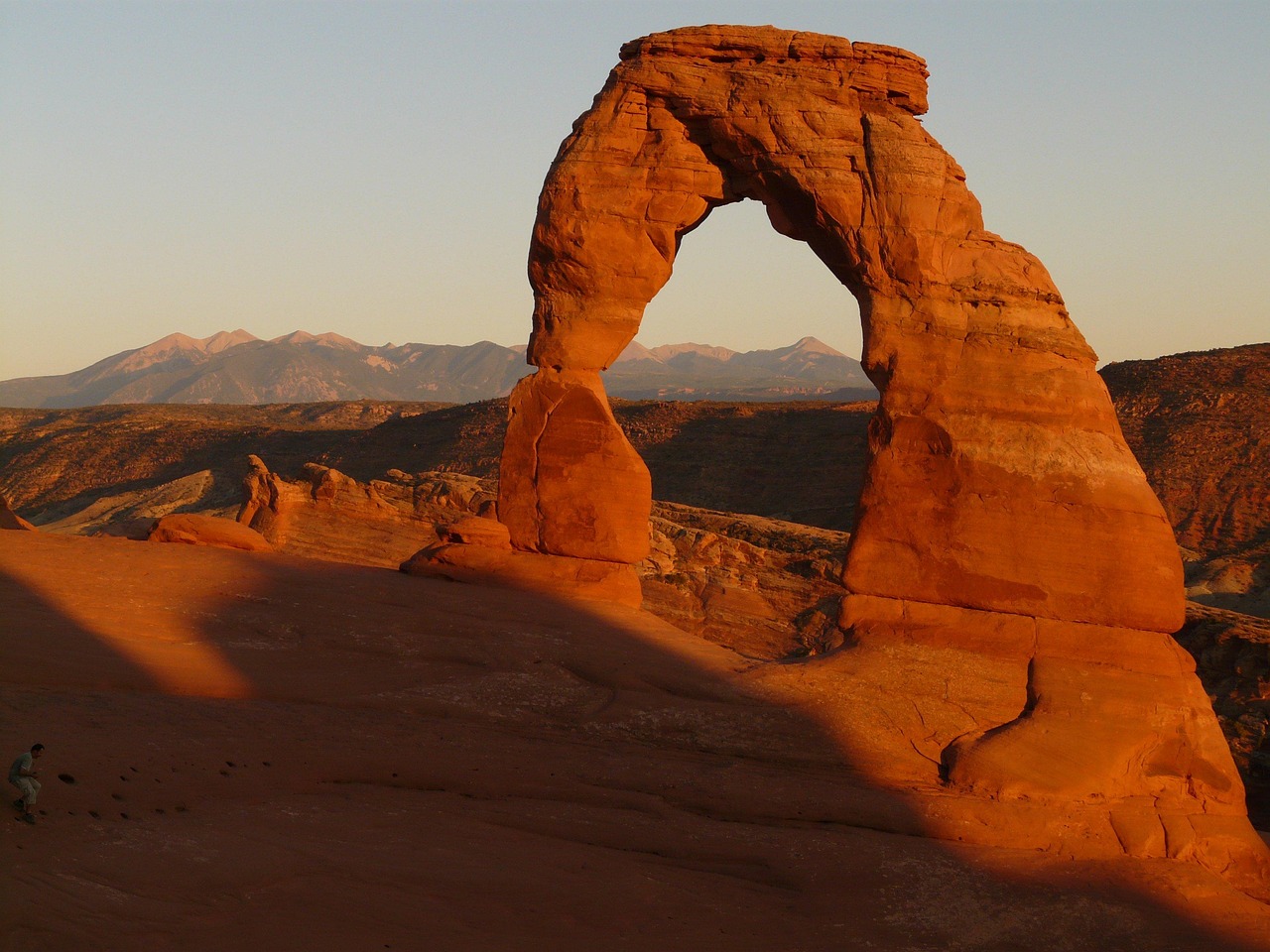Choosing the right place for your next adventure can be tough. Arches National Park in Utah is home to over 2,000 natural stone arches. This blog will show you why it’s a must-see, from its stunning arches to fun activities.
Keep reading to discover more!
Key Takeaways
- Arches National Park in Utah has over 2,000 natural stone arches, including famous ones like Delicate Arch and Landscape Arch. It’s a great place for hiking and seeing unique rock formations.
- The park’s arches formed over millions of years from erosion. Sandstone layers left by an ancient sea got carved into the stunning shapes we see today.
- Best times to visit are spring and fall when the weather is nice, and there aren’t as many people. You can do lots of fun things like stargazing, photography, and camping.
- There’s a lot of wildlife to see at Arches National Park. This includes animals like mule deer and desert cottontail rabbits, plus plants that have adapted to the desert.
- If you’re going to Arches National Park, plan ahead for entry fees and reservations. Moab is close by with places to stay but gets busy during peak seasons.
Key Features of Arches National Park

Arches National Park boasts iconic features like Delicate Arch, Landscape Arch, Double Arch, and Fiery Furnace. Each of these formations showcases the park’s unique sandstone landscape and natural beauty.
Geological wonders like rock fins and balanced rocks add to the allure of Arches National Park, creating a breathtaking sight for visitors.
Delicate Arch
Delicate Arch is a world-famous symbol not just of Arches National Park but also of Utah itself. It stands tall at 60 feet, creating a perfect frame against the sky. This natural stone arch draws visitors from all over for its unique shape and stunning location atop a sandstone hill.
To see it up close, you need to hike a 3-mile round trip trail that offers amazing views. The hike is worth every step, especially during sunset when the arch glows in brilliant shades of red and orange.
Many people come here to snap the perfect photo or just sit and enjoy the view. Delicate Arch has become an icon for its natural beauty and the sense of wonder it evokes. No visit to Moab or Arches National Park is complete without seeing it.
Landscape Arch
Moving from the iconic shape of Delicate Arch, Landscape Arch offers a different but equally stunning view. Found in Utah’s Arches National Park, this arch is one of the longest natural stone arches in the world.
It stretches an impressive 290 feet. Visitors come from all over to see its thin span against Moab’s sky.
Hiking to Landscape Arch is an adventure, too. The trail there is part of the Devils Garden Pathway, known for its beauty and challenge. This arch shows how sandstone can form into incredible shapes over time.
For anyone visiting Arches National Park, seeing Landscape Arch is a must-do experience.
Double Arch
After exploring the slender grace of Landscape Arch, head over to see Double Arch. It’s different because it has not one, but two massive arches that share a foundation. This makes it look stunning.
You can find it easily in the Windows section of Arches National Park, near Moab, Utah. These arches formed in a unique way due to erosion. Over time, water worked on cracks in the rock and made these huge openings.
Walking up to Double Arch is an easy hike that gets you right under the giant spans. People love taking pictures here because of how grand and close together these arches are. Plus, if you’re there at just the right time in the evening, the light makes them look even more amazing.
Fiery Furnace
The Fiery Furnace is a stunning labyrinth of narrow sandstone canyons at Arches National Park. It’s known for its intricate maze of towering rock walls, hidden arches, and awe-inspiring natural beauty.
The area gets its name from the glowing red hues that the rocks emit during sunset, creating a breathtaking sight for any visitor. Exploring the Fiery Furnace requires a permit or a guided ranger tour due to its complex and challenging terrain, making it an adventure not suited for everyone but well worth the effort for those seeking an unforgettable experience amidst nature’s wonders in this geologic marvel.
The rugged and otherworldly landscape of Fiery Furnace provides unique opportunities for adventurous hikers and those interested in ancient geological formations. This fascinating attraction showcases Utah’s astonishing natural beauty at every turn while offering visitors one-of-a-kind sights that they won’t find anywhere else on earth.
Geology and Arch Formation
The stunning natural stone arches in Arches National Park are the result of millions of years of geological processes, forming a unique landscape that attracts visitors from around the world.
To unravel the mysteries behind these extraordinary formations, delve into the fascinating geology and arch formation at Arches National Park.
How the arches were formed
The arches in Arches National Park were formed over millions of years by erosion from wind and water. The park’s unique rock formations, including natural stone arches, pinnacles, and rock fins, are made of sandstone.
This sandstone was once deposited as layers of sediment on an ancient seabed. Over time, the forces of nature gradually eroded the softer layers within the sandstone, leaving behind these remarkable features that we see today in the park.
The geologic processes at work here are ongoing, continually shaping and changing the landscape. Delicate Arch is one example of this ongoing change; it’s estimated to be around 10,000 years old but could potentially collapse in the future due to further erosion.
These geological wonders provide a window into Earth’s deep history and demonstrate the incredible power of natural forces over time.
Unique rock formations
Arches National Park is a treasure trove of unique rock formations that will leave you in awe. The park features over 2,000 natural stone arches formed by erosion and weathering over millions of years.
These sandstone wonders also include towering pinnacles, massive rock fins, and gravity-defying balanced rocks. One standout is the Landscape Arch, which spans the length equivalent to a football field making it one of the longest natural stone arches in the world.
This magical landscape offers countless opportunities for exploration and photography amidst the geological marvels.
The sandstone formations at Arches National Park are not only visually stunning but also provide insight into Earth’s intricate geological processes. Visitors can witness firsthand how wind and water have sculpted these unique rock structures into their present-day forms while admiring the breathtaking natural beauty surrounding them.
Climate and Weather
Arches National Park experiences varying weather conditions throughout the year, making spring and fall the best times to visit. Discover more about the park’s diverse climate on our blog!
Best times to visit
The best times to visit Arches National Park are from late March to early June and mid-September to late October. During these periods, the weather is mild, and the park is less crowded.
- Late March to early June:
- Pleasant temperatures for outdoor activities
- Wildflowers blooming, adding vibrant colors to the landscape
- Longer daylight hours for extended exploration
- Mid-September to late October:
- Cooler temperatures make hiking more comfortable
- Fall foliage provides a beautiful backdrop for photography
- Reduced crowds compared to peak summer months
Seasonal highlights
Arches National Park showcases different charms throughout the year. Here are the seasonal highlights:
- Spring brings mild temperatures, blooming wildflowers, and longer daylight hours, perfect for hiking and exploring the park.
- Summer offers clear skies for stargazing at night and early morning hikes to avoid the midday heat.
- Fall displays stunning colors as the cottonwoods and other trees change, making it an ideal time for photography enthusiasts.
- Winter provides a quieter experience with occasional snow dusting the red rock formations creating a unique landscape for photographers.
These seasonal variations make Arches National Park a captivating destination year-round.
Recreational Activities
Explore the numerous hiking trails, capture stunning photographs, gaze at the starry night sky, and experience outdoor camping under the stars. Get ready for an adventure-filled vacation at Arches National Park!
Hiking
Arches National Park offers various hiking trails that cater to different skill levels.
- Delicate Arch Trail is a moderately strenuous 3-mile round trip hike taking about 2-3 hours.
- The Landscape Arch Trail is an easy, flat 1.6-mile round trip suitable for all ages.
- Double Arch Trail is a short and easy 0.5-mile loop trail leading to two impressive arches.
- Fiery Furnace offers ranger-guided tours through a maze of narrow sandstone canyons (permits required).
Photography
Explore the breathtaking natural beauty of Arches National Park through photography. Capture the unique rock formations, arches, and sandstone landscapes that have been formed over millions of years.
Utilize the soft morning light or the warm glow of sunset to enhance your photographs. Don’t forget to pack a wide-angle lens for those expansive views and a telephoto lens to capture details from a distance.
As you plan your visit, consider attending one of the park’s photography workshops or guided tours led by experienced photographers who can help you find the best vantage points and lighting conditions.
Remember to bring extra batteries and memory cards since you’ll be tempted to take many pictures! Whether you’re an amateur enthusiast or a seasoned pro, Arches National Park offers endless opportunities for picture-perfect moments amidst stunning natural scenery.
Next up – “Stargazing” will unlock fascinating celestial experiences during your trip.
Stargazing
Clear skies and minimal light pollution make Arches National Park an ideal place for stargazing. The park’s dark night sky provides a fantastic opportunity to observe countless stars, planets, and celestial phenomena.
Don’t forget your binoculars or telescope when you visit the park to experience the breathtaking beauty of the night sky.
You can witness striking views of constellations, meteor showers, and even the Milky Way from various vantage points across the park. Joining one of the ranger-led stargazing programs can further enrich your experience by providing insights into astronomy while enjoying nature’s celestial display.
Keep in mind that Arches National Park’s stargazing opportunities vary depending on seasonal factors like moon phases and weather conditions.
Camping
Arches National Park offers a unique camping experience, allowing visitors to immerse themselves in the natural beauty.
- Campsites available for reservation online or first-come, first-served
- Backcountry camping permits required for overnight stays outside designated campgrounds
- Developed campground at Devils Garden offering basic amenities like water and toilets
- Primitive camping amongst juniper trees providing a peaceful setting
- Campfires allowed only within established fire pits to preserve the ecosystem.
Wildlife and Plant Life
Explore the diverse plant life, from juniper trees to prickly pear cacti. Keep an eye out for resident wildlife like mule deer and desert cottontail rabbits during your visit.
Native plants
Arches National Park is home to a variety of native plants uniquely adapted to the harsh desert environment. The park’s flora includes species like blackbrush, sagebrush, yucca, and prickly pear cactus.
These plants have evolved to thrive in the hot, dry climate and play a vital role in supporting the park’s ecosystem.
The resilient native plants not only add to the scenic beauty of Arches National Park but also provide essential habitat for wildlife such as mule deer, kit foxes, and many species of birds.
Visitors can marvel at these remarkable plant adaptations while exploring the breathtaking landscapes within the park.
Common animal species
Arches National Park is home to a variety of wildlife. Visitors may spot mule deer, desert bighorn sheep, and cottontail rabbits roaming the park. Birdwatchers can look out for golden eagles, peregrine falcons, and red-tailed hawks soaring above the unique rock formations.
During your visit, keep an eye out for lizards like the collared lizard and side-blotched lizard that thrive in the arid environment. The park’s diverse ecosystems also support smaller mammals such as kit foxes, black-tailed jackrabbits, and various species of bats that are active during the night hours.
Tips for Visiting Arches National Park
For visiting Arches National Park, be sure to make entry reservations in advance and check the park’s fees. Getting around the park is convenient with paved walks and even a sunset tour available for optimal experiences.
Entry reservations and fees
Make sure to get your entry reservations in advance, especially during peak seasons like spring and fall when the park gets very crowded. The entrance fee is $30 per vehicle and it’s valid for seven consecutive days.
For pedestrians or cyclists, it’s $15 per person. If you plan to visit multiple national parks within a year, consider getting the America the Beautiful pass for $80 which grants access to all national parks and federal recreational lands for one year from the month of purchase.
Upon arriving at Arches National Park, remember that you’ll need to pay an entry fee. It’s best to make reservations beforehand, especially during busy seasons like spring and fall when demand is high.
A vehicle entrance pass costs $30 and is good for seven consecutive days; while pedestrian or cyclist passes cost $15 per person. An alternative option worth considering is the America the Beautiful pass priced at $80, granting access to all national parks and federal recreational lands across the country for a whole year from the date of purchase – great value if you’re planning visits throughout several parks within that timeframe!
Getting around the park
To explore Arches National Park, consider these essential tips for getting around:
- Drive: The park has a scenic 18-mile paved road, making it easy to access major viewpoints and trailheads by car.
- Shuttle Service: During peak season (April-October), the park operates a convenient shuttle service to alleviate traffic congestion and parking issues.
- Biking: Cyclists can enjoy designated biking trails within the park, offering an alternative way to see the stunning landscape.
- Hiking: Many key attractions are accessible via short hikes from parking areas, providing opportunities for up-close exploration on foot.
- Guided Tours: Consider joining ranger-led programs or commercial tours to gain insightful perspectives on the park’s natural wonders.
- Accessibility: Several viewpoints and trails are wheelchair-accessible, ensuring that everyone can experience the beauty of the arches and rock formations.
Nearby accommodations
Moab, located just five miles from Arches National Park, offers a variety of accommodations that cater to every traveler’s needs. From cozy bed and breakfasts to luxury resorts and budget-friendly motels, visitors can find the perfect place to stay.
The town also has numerous campgrounds for those who want a more rustic experience. With over 2 million tourists visiting annually, there are ample options for lodging in Moab.
These accommodations tend to get booked quickly during the peak season. So it’s advisable to make reservations well in advance. Additionally, many lodgings offer shuttle services that provide convenient transportation to and from the national park entrance, making exploring this natural wonder even easier during your stay in Moab.
Conclusion
Arches National Park is a stunning destination full of natural wonders. From the iconic Delicate Arch to the unique rock formations, it’s a paradise for outdoor enthusiasts and nature lovers.
The park offers diverse activities such as hiking, stargazing, and camping against a backdrop of magnificent sandstone arches. For anyone seeking an unforgettable adventure immersed in breathtaking scenery and rich geological history, Arches National Park is an absolute must-visit.
FAQs
1. What is Arches National Park?
Arches National Park is a stunning area in Utah, famous for its natural stone arches and unique rock formations. It’s a great place to explore nature, hike trails, and enjoy beautiful views.
2. What activities can I do at Arches National Park?
At Arches, visitors can hike on various trails, take photographs of the amazing landscapes, go camping under the stars, and even join guided tours to learn more about the park’s geology and history.
3. When is the best time to visit Arches National Park?
The best times to visit are spring and fall when temperatures are mild. Summers can be very hot while winters might bring snow but also fewer crowds.
4. Are there any facilities available in Arches National Park?
Yes! The park has visitor centers offering information about trails and safety tips. There are restrooms throughout the park as well as picnic areas where families can relax after exploring all day long.







Leave a Reply